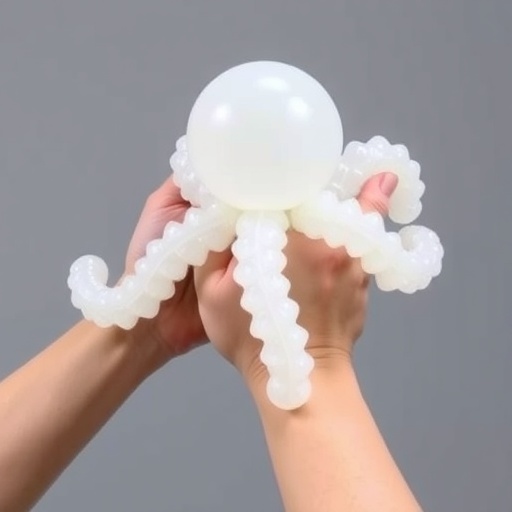In the ever-evolving landscape of soft robotics, a groundbreaking innovation has emerged from a coalition of multidisciplinary researchers, introducing an octopus-inspired hydrogel gripper that redefines the manipulation of ultra-soft materials in aqueous environments. This state-of-the-art device leverages the fascinating synergy of biomimicry, advanced material science, and precision engineering to address the longstanding challenges faced by conventional grippers in handling delicate submerged objects, ranging from fragile foods to sensitive biological tissues.
The core of this revolutionary gripper lies in its sophisticated construction from 3D printable supramolecular hydrogels—materials meticulously engineered to strike a balance between softness and toughness. These hydrogels exhibit tunable mechanical properties through the strategic interplay of strong and weak hydrogen-bond networks, resulting in remarkable stiffness adaptability. The material’s heterogeneity induced by microphase separation further imparts enhanced resilience, allowing the gripper to tolerate extensive cyclic loading and exhibit robust durability in challenging aqueous conditions without compromising integrity or function.
Inspiration drawn directly from the octopus sucker structure led to the ingenious design of a flexible sucker architecture featuring an alterable membrane. This membrane, integrated with a negative-pressure cavity, facilitates rapid and repeatable transitions between firm adhesion and gentle release, achieving what has been elusive in prior technologies—a nondestructive yet reliable grip on ultrafragile surfaces. Through curvature modulation of the membrane, the gripper can conform seamlessly to flat, convex, or concave geometries, optimizing contact area and securing objects without inducing damage.
The gripper’s hydraulic actuation mechanism is another feat of innovation, utilizing low-pressure water inflation to effect substantial morphological changes. By harnessing pressures under 40 kPa, the system achieves more than 60-fold volumetric expansion and bending angles surpassing 150 degrees within seconds. This actuation outperforms traditional silicone-based grippers, not only in energy efficiency but also in the magnitude of achievable deformation, opening new horizons for soft robotic applications requiring rapid and sensitive movements.
Manufactured via vat photopolymerization, the gripper and its multifingered tentacles embody high-resolution, bioinspired design principles achieved through scalable 3D printing techniques. This one-step fabrication method is poised to revolutionize the mass customization of tailored soft end-effectors, enabling the production of complex, multifunctional grippers with unprecedented precision and repeatability.
Underwater adaptability is a hallmark of this hydrogel-based system. The hydrophilic nature of the supramolecular hydrogels confers inherent lubrication and resistance to swelling, ensuring operational stability across diverse fluid environments, including seawater, phosphate-buffered saline, and purified deionized water. This intrinsic compatibility with wet conditions shields the gripper from common material degradation pathways, positioning it as an ideal candidate for long-term underwater deployments.
Potential applications of this novel soft gripper span a broad spectrum. In food processing and biomedical contexts, the device’s capacity to handle ultra-soft substances such as tofu blocks and delicate egg yolks without causing mechanical damage foregrounds its use in automated, high-precision operations where gentle manipulation is crucial. Moreover, the gripper’s performance with curved glass and plastic components hints at its versatility in handling delicate synthetic materials.
Beyond terrestrial and laboratory usage, this technology heralds exciting possibilities for underwater robotics. When mounted on unmanned underwater vehicles (UUVs) or hexapod crawling robots, arrays of these hydrogel suckers afford new modes of locomotion and station-keeping, including the ability to adhere firmly to inclined or horizontal surfaces and navigate ceilings in submerged environments. These capabilities have compelling implications for marine archaeology, deep-sea sampling, and pipeline inspection—fields where precision and delicacy are paramount.
Despite the breakthrough, challenges persist on the path to widespread adoption. The hydrogel grippers must contend with issues such as long-term fatigue resistance under continuous operation and the scalability of rapid, large-volume production. Furthermore, integration with embedded sensor arrays and real-time feedback control systems remains an area ripe for development, which could unlock adaptive behaviors and intelligent interaction with complex environments.
Future research avenues are set to explore hybrid composite structures combining hydrogels with elastomers, affording enhanced mechanical robustness alongside sensory functionality. Coupled with advancements in artificial intelligence for optimizing shape and actuation parameters, these efforts could culminate in next-generation soft robotic grippers tailored for extreme aqueous settings, responsive to evolving operational demands.
This octopus-inspired hydrogel gripper embodies an elegant convergence of bioinspired design and modern engineering, offering a scalable, cost-effective solution for delicate underwater manipulation that transcends the capabilities of existing soft robotic devices. Its novel features position it at the forefront of soft robotics, with the potential to catalyze innovations across medicine, food technology, and environmental exploration.
By synthesizing the gentle adhesion strategies perfected by marine cephalopods with advances in smart material fabrication, this development marks a paradigm shift. It provides not only tangible solutions for current technological barriers but also a blueprint for crafting intelligent, adaptable robotic systems capable of interacting safely and effectively with the softest and most complicated of environments.
In conclusion, this work represents a significant leap toward creating soft robotic grippers that combine resilience, precision, and scalable manufacturing, ultimately enhancing human capabilities in both everyday and extreme aquatic scenarios.
Subject of Research: Advanced Hydrogel-based Soft Robotics for Underwater Manipulation
Article Title: Octopus‑Inspired Self‑Adaptive Hydrogel Gripper Capable of Manipulating Ultra‑Soft Objects
News Publication Date: 19-Aug-2025
Web References: 10.1007/s40820-025-01880-4
Image Credits: Yixian Wang, Desheng Liu, Danli Hu, Chao Wang, Zonggang Li, Jiayu Wu, Pan Jiang, Xingxing Yang, Changcheng Bai, Zhongying Ji, Xin Jia, Xiaolong Wang
Keywords: Hydrogels, Soft Robotics, Biomimicry, Supramolecular Polymers, 3D Printing, Underwater Manipulation, Hydraulic Actuation, Soft End-Effectors




